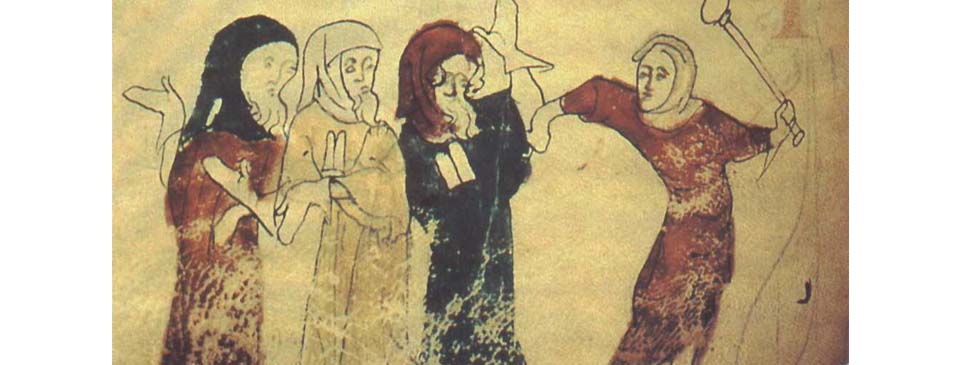The Jews of Medieval London

This illustration is from the margin of the manuscript ‘The Rochester Chronicle’, created in 1355 by the monk Edmund of Haddenham. It illustrates the expulsion of the Jews from England.
The monarchs eventually realised it would be more advantageous to tax the Jews instead of borrowing from them. Henry II protected them but taxed them heavily and confiscated a quarter of their wealth in 1187.
With many of the country’s upper classes in debt to them, the Jews were always a source of resentment. In part, that stemmed from a general antipathy towards, and the misunderstanding of, interest payments in a Christian society when usury was not common. The Crusades instilled in people an animosity towards non-believers. At the coronation of Richard I at Westminster Abbey in 1189 officials, misunderstanding their motives, barred Jews from entering to present their gifts and had them stripped and flogged. The violence spread from Westminster to London and rioting took place in which 30 Jews were killed and their homes burnt. Richard of Devizes described it as a “holocaust”, from the old French word holocauste, which itself is derived from the Greek word holokauston. Some of their number sheltered in the Tower of London for protection. Englishmen attacked Jews around the country, including the entire community of York, who decided to commit suicide rather than fall into the hands of the mob. The King, who needed the Jews’ finance, sought out and punished the ringleaders.
Thereafter, however, English Jews were subjected to regular persecution for the next century. When King Richard was kidnapped in Austria in 1192 on his return from the Third Crusade his brother John made the Jews help pay for the ransom payment. At the end of the 12th century Jews were less than 0.25 percent of the population but providing eight percent of the income of the royal treasury.
After he became king, John confirmed the Jews’ earlier liberties. He bankrupted the country with disastrous wars against France, however, and desperately needed finance. He imprisoned and tortured Jews in 1210, demanding a ransom for their release, and imposed such onerous taxes that many gave up and left the country. Furthermore, he needed to keep his barons on his side so allowed them to plunder Jewish assets. The version of Magna Carta that the barons forced John to sign included two sections regarding Jews and money-lending and limited the amount of interest due to Jews in the event of a creditor’s death.
As popular opinion turned against England’s Jewish community there were increasing incidents of persecution, either officially sanctioned or by mob rule. In 1173 a monk in Norwich accused local Jews of ritually murdering a boy in the town. Thereafter there were always rumours and suspicions about the Jews each time a boy was found dead. On each occasion clergy were quick to canonise the diseased, indicating that it was motivated by a desire to create martyrs, known as ‘blood libel’, to attract lucrative pilgrims to the local cathedral. The most famous such event happened in Lincoln in 1255, when a boy named Hugh was found dead. Henry III travelled there in person, condemned one Jew to be executed and 90 to be imprisoned in the Tower of London. Of the prisoners, 18 were hanged for refusing to be tried, and their properties seized by the Crown. The others were pardoned after the intervention of Dominican and Franciscan friars.
Henry III made the Jews pay a heavy burden in taxes and gradually took away their former rights and protections. They were barred from town after town and from 1269 banned from owning property except the house in which they lived. They were restricted to burying their dead in only the burial ground at London, so the bodies of any of them had to be brought there from where they died in the country. After their death their money went not to their children but to the Crown. David of Oxford was reputably the wealthiest Jew in England. When he died in 1244 Henry imprisoned his widow, Licoricia of Winchester, in the Tower of London until most of David’s wealth was handed over to the King. He used the money to pay for rebuilding at Westminster Abbey and the shrine to Edward the Confessor.


